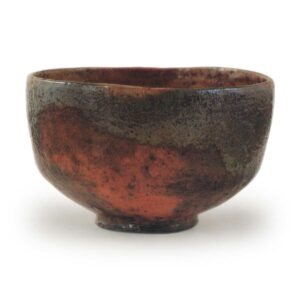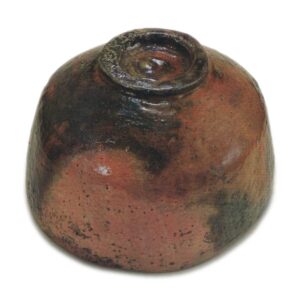

Height: 8.0cm
Diameter: 13.0cm
Base diameter: 5.3cm
Height: 0.6cm
Kore-iro is the signature of Sōtan. It is needless to say that it is based on the Buddhist scripture “Shiki-soku-zoku-kū, Kū-soku-shiki-zoku”. Among the many red tea bowls of Nōkō, this is a tea bowl of a different color, literally, with the most drastic change in color tone.
First of all, it has a good shape. It is a typical Nōkō shape, with a large, slightly thin, and relaxed appearance. As usual, the brushwork is meticulous, and you can see the fine technique through the glaze. Also, when you pick it up, the subtle texture of the clay is even more wonderful. The rim of the mouth is slightly turned inwards, and the gentle curve of the rim shows a natural, smooth line. In addition, the rich curves that wrap around the whole piece are a nod to the skill that Koetsu praised as being “extraordinary”. The foot is strongly incised, and the tatami mat-like base is as wide and flat as promised, with the inside of the bowl swirling powerfully in a spiral shape. Normally, you would see the “raku” mark of Nonkou on the inside or outside of the foot ring, but this tea bowl is unusual in that it is unmarked.
Now, in contrast to the generous exterior, the change in color tone is truly intense, and this strangeness is the most notable feature of this tea bowl. The glaze is a light pink with a milky white tinge, which, when combined with the clay color of the base, should have given the bowl a warm, reddish-brown color. However, due to an unexpected change in the fire in the kiln, most of the base has turned a dull gray, resulting in an overall unusual color tone. From a pale, whitish vermillion to a slightly darker vermilion, and from a pale gray to a dull grayish black, the surface of the bowl is covered with “color irregularities” of various shades and sizes, and the enchanting transformation is endless.
In particular, the area where the lead-colored and vermilion-red areas are mixed together, showing a large change along the rim, is a truly extraordinary sight. Sometimes, non-glazed red tea bowls show this type of kiln-induced change in part, but it is extremely rare to find a bowl with a color tone that changes so greatly and intensely across the entire surface, as in this tea bowl. The depth of the appreciation expressed in the inscription by Sōkatsu is nothing short of astonishing.
The inside of the bowl is, surprisingly, not as varied as the outside, and is a single pale, soft red color, with only a slight darkening from the middle to the bottom, and four or five grains of sand adhering to it.
For the purpose of appreciating the tea, this level of monotony on the inside may be rather suitable.
Apart from a small repair on one side of the rim, there are few flaws, and they are almost unnoticeable.
The accompanying items are
Inner box, inscription on the lid: Sōtan “Red tea bowl
Inscription on the underside of the lid: ”This is the color (signature)
and separately,
I have received your letter (this afternoon) and I am respectfully requesting that you allow me to have tea with you. I will be visiting Daitokuji Temple in the morning and will return early. I respectfully request your kind consideration. Sincerely yours, Jyukka (signature) I have named this Raku tea bowl “Jyukka” and I respectfully request that you keep it for a long time. I have sent a messenger to return it to you. Sincerely yours, Tokuji
.
It was passed down through the hands of the Toda family of Tanimatsuya, who were in charge of the collection at the time, and is now in the collection of a certain family in Osaka.



